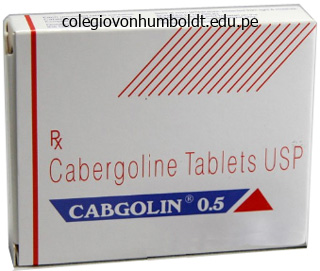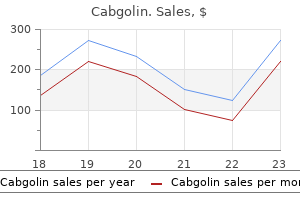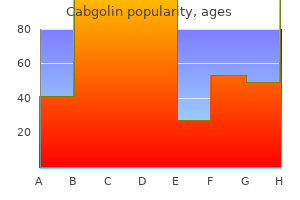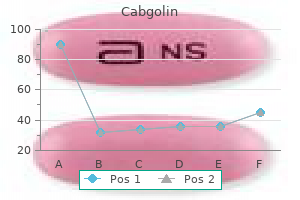Cabgolin
Cabgolin dosages: 0.5 mg
Cabgolin packs: 10 pills, 30 pills, 60 pills, 90 pills

Best buy cabgolin
Fibrocartilage is usually present in anatomic areas where pressure and shearing forces are regularly encountered. These anatomic places embrace intervertebral discs, pubic symphysis, and insertion factors of tendons and ligaments. The combination of hyaline cartilage with bundles of kind I collagen makes fibrocartilage particularly proof against compression, in addition to tearing and shearing forces. Because fibrocartilage lacks a perichondrium layer, its improvement and restore depend on interstitial development. Keywords: Epiphyseal plate, hyaline cartilage 22 the reply is A: Avascularity of the cartilage matrix. Hyaline cartilage has a restricted capacity for repair and regeneration owing to poor vascular supply and the relative immobility of resident chondrocytes. Granulation tissue that forms at the wound floor is replaced over time by fibrous (collagen-rich) scar tissue, or in some circumstances, by bone arising from activated mesenchymal stem cells. If an injury to cartilage entails the perichondrium, mesenchymal stem cells can differentiate into fibroblasts and/or osteoblasts as an alternative of chondroblasts. The mechanisms that regulate cartilage restore and regeneration are poorly understood. The photomicrograph in this case reveals malignant chondrocytes embedded in a cartilaginous matrix. Type I collagen, organized into parallel and/or concentric lamellae, is the most important structural part of bone matrix. Type I collagen together with traces of other collagens accounts for 90% of the entire protein current in bone matrix. Ground substance including glycoproteins and proteoglycans are minor parts, comprising 10% of whole bone matrix protein. Aggrecan (choice A) and glycosaminoglycans (choice E) comprise proteoglycans found in cartilage. Osteoblasts are responsible for the secretion of a new bone matrix, as properly as bone matrix calcification and mineralization. Osteoblasts not solely actively secrete natural parts of the bone matrix, but in addition initiate the calcification course of. Osteocytes can still synthesize a brand new matrix and also are involved in bone resorption, subsequently sustaining the bone matrix. Osteoclasts (choice D) are bone resorption cells and actively involved in bone remodeling. They have been proven to induce the differentiation of mesenchymal stem cells into osteoblasts that actively produce new bone matrix. Keywords: Spinal fusion surgical procedure, bone morphogenetic proteins 27 the answer is C: Haversian methods. In the center of a compact bone, lamellae are organized into concentric sheets around a central canal that contains blood vessels and nerves, forming a cylindrical unit 52 Chapter four referred to because the haversian system or osteon. Because bone undergoes fixed remodeling, new osteons develop and older osteons become incomplete, forming interstitial lamellae (choice D). Circumferential lamellae are discovered along the outer and inside circumferences of the bone, parallel to the floor of the bone. Volkmann canals (choice E) can be seen on the figure connecting the haversian canals (choice B). Bone spicules (choice A), additionally referred as trabeculae, type a three-dimensional meshwork within the marrow of spongy bone. Ultrastructural studies have proven that collagen fibers in bone spicules are organized into parallel lamellae missing vascular cores. Lacunae are areas throughout the bone matrix that contain osteocytes in residing tissue. In a ground section, where cells and other organic components are removed, lacunae appear as empty areas.
Best purchase cabgolin
Prevention by avoidance of smoking is crucial strategy within the fight towards lung cancer. About 15% of lung cancers are small-cell carcinomas and are finest handled by chemotherapy followed by radiotherapy. About 85% are non-small-cell carcinomas and require careful staging and assessment for potential operability. About 10�20% of non-small-cell carcinomas are suitable for surgery but only 30% of patients undergoing resection might be alive in 5 years. A even handed plan of evaluation allows careful choice of your finest option of specific anticancer therapy, with both healing or palliative intent. Symptom relief and palliative care are crucial elements within the overall management, and the communication of knowledge between physician and patient at all phases of the disease is of paramount significance. Sometimes the tumour is up-staged after surgery when histology exhibits extra in depth illness, and adjuvant chemotherapy could additionally be used. Biopsy of the mediastinal nodes might then be undertaken by mediastinosopy or by endobronchial ultrasound-guided needle aspiration. Only about 10�20% of non-small-cell carcinomas are appropriate for surgical resection, due to the advanced stage of the illness at prognosis. Chemotherapy can improve the survival and quality of life of some sufferers with advanced non-small-cell lung most cancers. First-line chemotherapy usually consists of cisplatin or carboplatin combined with gemcitabine, paclitaxel or vinorelbine. Docetaxel could additionally be used as second-line remedy when relapse happens after earlier chemotherapy, although a variety of regimens are available. The role of chemotherapy before (neoadjuvant) and after (adjuvant) surgical procedure is being studied in ongoing medical trials. Regular evaluate of sufferers with lung most cancers is essential in providing assist and in figuring out the nature and origin of signs as they arise. Often, pain control is achieved by use of slow-release morphine tablets 12-hourly, with additional use of morphine solution for any breakthrough pain. Certain kinds of pain might profit from the use of co-analgesics, corresponding to steroids. Anorexia, weight loss, fatigue and general debility are frequent within the advanced phases of lung most cancers. It is important to verify for conditions requiring specific remedy, corresponding to anaemia (blood transfusion) or hypercalcaemia (pamidronate). Prednisolone may be useful in boosting urge for food, and dietary supplements may be helpful. When the tumour is confined to one lobe, surgical resection is the remedy of alternative. Carcinoid tumour this uncommon tumour is much less malignant than bronchial carcinomas in that it hardly ever metastasises and is often slow-growing, though it may invade regionally. At bronchoscopy, the tumour usually has a easy rounded appearance, resembling a cherry, and it might bleed profusely on biopsy due to its vascularity. Lymphoma, metastatic carcinoma, mediastinal tumours and thrombosis of central veins can also cause it. Other thoracic neoplasms Alveolar cell carcinoma (lepidic adenocarcinoma) this may be a uncommon malignant tumour that arises within the alveoli of the lung and spreads along the alveolar and bronchiolar epithelium. Targeted remedy for the remedy of advanced non-small cell lung cancer: a review of the epidermal growth factor receptor antagonists. Chest X-ray shows a widened bulky mediastinal shadow with a 2 cm opacity within the left higher lobe. The scientific features counsel: A dissection of the thoracic aorta B nephrotic syndrome C central venous thrombosis D superior vena caval obstruction E thymoma 12. The staging of this carcinoma is: A T1aN0M0 B T1bN0M0 C T3N1M0 D T1aN0M1 E T2N0M1 12.

Buy cabgolin master card
The therapeutic index represents an estimate of the safety of a drug, because a really safe drug may be expected to have a very massive poisonous dose and a a lot smaller efficient dose. Furthermore, factors such because the varying slopes of dose-response curves make this estimate a poor security index even in animals. The therapeutic window, a extra clinically useful index of safety, describes the dosage range between the minimum efficient therapeutic concentration or dose, and the minimum toxic focus or dose. For example, if the average minimum therapeutic plasma concentration of theophylline is eight mg/L and toxic effects are noticed at 18 mg/L, the therapeutic window is 8�18 mg/L. Both the therapeutic index and the therapeutic window rely upon the specific poisonous impact used within the determination. The receptor-effector system could also be an enzyme in the intracellular area (eg, cyclooxygenase, a goal of nonsteroidal anti-inflammatory drugs) or in the membrane or extracellular house (eg, acetylcholinesterase). Most antiarrhythmic drugs goal voltageactivated ion channels in the membrane for sodium, potassium, or calcium. For the largest group of drug-receptor interactions, the drug is present within the extracellular area, whereas the effector mechanism resides contained in the cell and modifies some intracellular process. The effector molecule could also be part of the receptor or separate Insulin, epidermal development factor, and similar agents bind to the extracellular domain of molecules that incorporate tyrosine kinase enzyme exercise of their intracellular domains. For instance, the molecule -arrestin has been proven to bind to an intracellular loop of the adrenoceptor when the receptor is constantly activated. Beta-arrestin prevents access of the Gs-coupling protein and thus desensitizes the tissue to additional -agonist activation within minutes. Removal of the agonist leads to removal of -arrestin and restoration of the total response after a couple of minutes or hours. Second, agonist-bound receptors may be internalized by endocytosis, eradicating them from additional publicity to extracellular molecules. The internalized receptor molecule might then be either reinserted into the membrane (eg, morphine receptors) or degraded (eg, adrenoceptors, epidermal progress factor receptors). In some circumstances, a cyclic internalization-reinsertion course of may actually be needed for regular functioning of the receptor-effector system. Third, continuous activation of the receptor-effector system might lead to depletion of some essential substrate required for downstream effects. For instance, depletion of thiol cofactors could also be liable for tolerance to nitroglycerin. In some circumstances, repletion of the lacking substrate (eg, by administration of glutathione) can reverse the tolerance. Long-term reductions in receptor number (downregulation) may occur in response to steady exposure to agonists. The reverse change (upregulation) occurs when receptor activation is blocked for extended intervals (usually a quantity of days) by pharmacologic antagonists or by denervation. Prior to scientific trials in patients with coronary heart failure, an animal study was carried out to examine two new optimistic inotropic drugs (A and B) to a current normal agent (C). A study was carried out in isolated intestinal clean muscle preparations to decide the action of a brand new drug "novamine," which in separate studies sure to the identical receptors as acetylcholine. In the presence of a high concentration of novamine, extraordinarily excessive concentrations of acetylcholine had no impact. Several studies have indicated that in people and experimental animals, about 90% of adrenoceptors in the coronary heart are spare receptors. Thiazide A in a dose of 5 mg produces the identical lower in blood stress as 500 mg of thiazide B. Graded and quantal dose-response curves are getting used for analysis of a brand new antiasthmatic drug in the animal laboratory and in scientific trials. Drug Dose (mg) 5 10 20 50 100 200 Percent Responding to Drug X 1 5 10 50 70 ninety Percent Responding to Drug Y 10 20 50 70 90 a hundred 9. Which of the curves in the graph describes the proportion effect noticed when a big dose of full agonist is current throughout the experiment and the concentration of a partial agonist is elevated from low to very high ranges Which of the curves within the graph describes the share of binding of the partial agonist whose effect is proven by Curve four if the system has many spare receptors Sugammadex is a model new drug that reverses the action of rocuronium and certain different skeletal muscle-relaxing agents (nondepolarizing neuromuscular blocking agents). It seems to interact immediately with the rocuronium molecule and not at all with the rocuronium receptor.


Purchase line cabgolin
The superficial layer of this stratified epithelium features squamous cells that have undergone programmed cell death. As they bear apoptosis, the keratinocytes go away behind an insoluble layer of keratin intermediate filament proteins (eosinophilic layer, seen in the image). None of the opposite forms of epithelium describes histologic options of the dermis. This picture shows sweat ducts which might be lined by a double layer of cuboidal epithelial cells. Tight (occluding) junctions between the ductal epithelial cells kind an impermeable barrier. It may reflect the necessity for greater support, or it may represent a transition zone for epithelial tissues that are switching from easy to stratified. None of the opposite types of epithelium describe histologic features of these sweat ducts within the dermis of the pores and skin. As mentioned above, capillary endothelial cells are characterized by the presence of tight junctions that establish a permeability barrier between blood and extravascular interstitial tissue. These occluding junctions (zonula occludens) deliver the lipid bilayers of adjoining cells into close proximity. Zonula occludens are composed principally of three proteins: occludin, claudin, and junctional adhesion molecule. The extracellular parts of those transmembrane proteins kind a zipper-like construction that seals the intercellular space and limits paracellular fluid transport. Parenthetically, transcellular transport happens when biomolecules move across the plasma membrane. These cellular adjustments result in the leakage of fluid from the blood into the surrounding extravascular space (referred to as edema fluid). In some organs, capillary endothelial cells exhibit small home windows (fenestrae) that facilitate the transport of biomolecules across the endothelium. Keywords: Tight junctions, zonula occludens 12 the reply is B: Stratified columnar. This image reveals stratified columnar epithelium lining an excretory duct within the lip. None of the opposite types of epithelial tissue describes the histologic options of this huge excretory duct. Keywords: Excretory duct 26 Chapter 2 thirteen the answer is B: Loss of cell contact inhibition of growth and motility. In transient, maturation of the epidermis requires an intact layer of basal stem cells which would possibly be in direct contact with each other. If this contact is disrupted, basal cells at the margin of the wound turn into activated. When epithelial continuity is reestablished, cell migration and cell division stop, and normal epidermal maturation resumes. This mechanism of epithelial growth regulation is referred to as "contact inhibition of growth and motility. The other choices describe responses to deep wounds that contain the formation of granulation tissue. Keywords: Skin abrasion, epithelial regeneration 14 the reply is E: Transitional. The renal calyces, ureters, urinary bladder, and proximal urethra are lined by a transitional epithelium. Urothelium is stratified and appears to consist of 5 - 6 cell layers when the bladder is empty (shown within the image). Upon distention, nonetheless, the identical epithelium would appear to encompass only three layers. The superficial cells are sometimes described as being cuboidal and dome shaped, as a result of they appear to bulge into the lumen. Hematuria may be a symptom of an ascending urinary tract infection or (less commonly) bladder most cancers. None of the opposite forms of epithelium describes histologic features of the bladder mucosa.

Purchase genuine cabgolin line
The signs of pleural effusion are decreased enlargement on the aspect of the effusion, stony dullness, diminished breath sounds and decreased tactile vocal fremitus. Pleural fluid could be troublesome to detect if the chest X-ray is carried out with the patient mendacity supine and should only be suspected by haziness on the affected aspect. A lateral decubitus movie may be helpful in demonstrating mobility of the fluid, distinguishing the options from pleural thickening. Bloodstained fluid points towards malignancy, pulmonary infarction or extreme irritation. Pus indicates an empyema, milky white fluid suggests a chylothorax and frank blood suggests a haemothorax. A low glucose content points in the direction of infection or a connective tissue disease as a reason for the effusion. A high amylase content is attribute of pleural effusion related to pancreatitis but also sometimes occurs with adenocarcinoma. Microbiology examination of the fluid could determine tuberculosis or bacterial an infection. Video-assisted thoracoscopy permits direct inspection of the pleural surfaces, with direct biopsy of irregular tissue. Histology of pleural biopsy samples is particularly useful in diagnosing malignant effusions or tuberculosis. A sample of the biopsy also wants to be despatched for culture for Mycobacterium tuberculosis. They arise on account of changes in hydrostatic or osmotic pressures across the pleural membrane somewhat than from illness of the pleura. On examination, there was stony dullness and diminished breath sounds over the left hemithorax. The chest X-ray shows options of a big pleural effusion, with a dense white shadow with a concave higher border over the left aspect of the chest. The pleural fluid was bloodstained and showed metastatic adenocarcinoma on cytology. Bronchoscopy showed the primary tumour partly occluding the left lower lobe bronchus. An intercostal drain was inserted to evacuate the fluid and talc was instilled to obtain pleurodesis. Transudates the main causes of transudative pleural effusions are cardiac failure, renal failure, hepatic cirrhosis and hypoproteinaemia attributable to malnutrition or nephrotic syndrome. In most cases, transudative effusions are bilateral, though they could be asymmetrical and initially unilateral. Ascitic fluid could move through pleuroperitoneal communications, that are extra frequent in the right hemidiaphragm. Sometimes, therapy of cardiac failure with diuretics leads to an increase in fluid protein content material, in order that the effusion appears to be an exudate. Treatment of transudates includes correction of the underlying hydrostatic or osmotic mechanisms. The curvilinear white line to the right of the picture is the diaphragm above the liver. Exudates A variety of illnesses that affect the pleura are related to increased capillary permeability or decreased lymphatic drainage. Exudates are sometimes unilateral and investigations are directed towards identifying the cause, as a result of this determines therapy. Metastases to the pleura mostly come up from lung, breast, ovarian or gastrointestinal cancers and from lymphoma. Mesothelioma is a primary tumour of the pleura related to asbestos publicity (see Chapter 14). In malignant effusions, the fluid is often bloodstained, with a excessive lymphocyte depend, and cytology usually reveals malignant cells. Sometimes, confirmation of the prognosis is troublesome and thoracoscopy with biopsy of lesions underneath direct vision could also be essential. Malignancy may give rise to pleural effusions by means other than direct involvement of the pleura.
Cheapest cabgolin
This ends in the release of glycine, which, via interaction with its receptors on the motor neuron, causes membrane hyperpolarization, an example of suggestions inhibition. Agents that activate presynaptic 2 receptors on such neurons (eg, clonidine, methyldopa) lower central noradrenergic activity, an motion thought to result in decreased vasomotor outflow. Identify the sites of drug action at synapses and the mechanisms by which drugs modulate synaptic transmission. Newer medicine with distinctive characteristics include the anxiolytic buspirone, several broadly used hypnotics (zolpidem, zaleplon, eszopiclone), and melatonin agonists and orexin antagonists, novel medication utilized in sleep issues. Absorption and Distribution Most sedative-hypnotic medication are lipid-soluble and are absorbed properly from the gastrointestinal tract, with good distribution to the brain. Metabolism and Excretion Sedative-hypnotics are metabolized earlier than elimination from the body, primarily by hepatic enzymes. Many benzodiazepines are converted 186 initially to energetic metabolites with lengthy half-lives. After a quantity of days of remedy with some medicine (eg, diazepam, flurazepam), accumulation of lively metabolites can lead to excessive sedation. With the exception of phenobarbital, which is excreted partly unchanged in the urine, the barbiturates are extensively metabolized. Rapid metabolism by liver enzymes is liable for the short length of motion of zolpidem. Zaleplon undergoes much more rapid hepatic metabolism by aldehyde oxidase and cytochrome P450. Certain drugs (eg, benzodiazepines) facilitate neuronal membrane inhibition by actions at particular receptors. In this isoform, the binding web site for benzodiazepines is between an 1 and the 2 subunit. They may block the excitatory transmitter glutamic acid, and, at excessive focus, sodium channels. A hetero-oligomeric glycoprotein, the complex consists of 5 or more membrane�spanning subunits. Binding of benzodiazepines and the newer hypnotic medicine such as zolpidem occurs at a single web site between and subunits, facilitating the process of chloride ion channel opening. The benzodiazepine antagonist flumazenil also binds at this website and may reverse the hypnotic results of zolpidem. These effects vary from sedation and aid of hysteria (anxiolysis), through hypnosis (facilitation of sleep), to anesthesia and coma. The steepness of the dose�response curve varies among drug groups; these with flatter curves, such as benzodiazepines and the newer hypnotics (eg, zolpidem), are safer for medical use. Sedation Sedative actions, with reduction of hysteria, occur with all medication on this class. Anxiolysis is normally accompanied by some impairment of psychomotor capabilities, and behavioral disinhibition can also occur. In animals, most standard sedative-hypnotics release punishment-suppressed behavior. Hypnosis Sedative-hypnotics can promote sleep onset and enhance the period of the sleep state. Effects on sleep patterns occur occasionally with newer hypnotics similar to zaleplon and zolpidem. Anesthesia At excessive doses of most older sedative-hypnotics, lack of consciousness could occur, with amnesia and suppression of reflexes. Anterograde amnesia is more doubtless with benzodiazepines than with different sedative-hypnotics. Anesthesia can be produced by most barbiturates (eg, thiopental) and sure benzodiazepines (eg, midazolam). Anticonvulsant Actions Suppression of seizure exercise occurs with excessive doses of most of the barbiturates and a few of the benzodiazepines, but that is normally at the price of marked sedation. High doses of intravenous diazepam, lorazepam, or phenobarbital are utilized in status epilepticus.
Purchase cabgolin
The registry of the worldwide society for coronary heart and lung transplantation: transplant report 2013. Bronchiolitis obliterans syndrome is an important complication threatening the long-term survival of patients with transplanted lungs. Patients have troublesome choices to make in balancing the quick high danger of dying while awaiting donor lungs from the slightly much less favourable long-term outcome of accepting organs from a donor who has smoked. Peripheral: Peripheral proteins localize to the membrane surface and may be weakly associated. Integral: Integral proteins span the width of the membrane, penetrating the lipid core. Intracellular fluid 1 Cytoskeleton Lippincott Illustrated Reviews Flash Cards: Physiology Copyright � 2015 Wolters Kluwer Diffusion Define the equation used to determine the rate at which molecules diffuse by way of gases or solutions. The illness is typified by persistent diarrhea and weight reduction from impaired nutrient absorption. Lippincott Illustrated Reviews Flash Cards: Physiology Copyright � 2015 Wolters Kluwer Membrane Transport What are the three principal modes of carrier-mediated membrane transport (one example is shown) This weakens the gradient driving Ca2 extrusion via the Na -Ca2 exchanger and raises intracellular Ca2. Because Ca2 equates with cross-bridge cycle numbers, myocardial inotropy and output are improved. Autocrine signaling (provides a suggestions pathway that acts on the cell originating the signal) Advantages to chemical communication include: � Economy: Chemical alerts can attain each cell in the body through blood. Chemical message Blood vessel Target cell Receptor Lippincott Illustrated Reviews Flash Cards: Physiology Copyright � 2015 Wolters Kluwer Intracellular Signaling What are the 5 numbered parts of the signal transduction pathway shown Lippincott Illustrated Reviews Flash Cards: Physiology Copyright � 2015 Wolters Kluwer 1. Lippincott Illustrated Reviews Flash Cards: Physiology Copyright � 2015 Wolters Kluwer Membrane Potentials What are the phrases used to describe the electrical occasions indicated by boxed numerals Outward present Membrane Potentials 1 Cation inflow causes an inward membrane present (Im) and depolarizes membrane potential (Vm). Hypokalemia steepens the transmembrane K gradient and causes membrane hyperpolarization. The mutations delay Na channel inactivation, thereby prolonging Na inflow and muscle depolarization. Patients suffer recurrent episodes of muscle weakness and paralysis related to mild hyperkalemia (5. Plasma membrane Pore + ++ Lippincott Illustrated Reviews Flash Cards: Physiology Copyright � 2015 Wolters Kluwer 1. A selectivity filter prevents ions of the mistaken size and charge from passing via the pore. Pore + ++ Inactivation gates might block the pore following activation, preventing additional ion fluxes. Cation Ion channels possess an activation gate that enables ions to enter the pore when open and a selectivity filter that discriminates between the assorted ion species. Subunit Selectivity filter Plasma membrane Pore Lippincott Illustrated Reviews Flash Cards: Physiology Copyright � 2015 Wolters Kluwer 1. Cys-loop channels are ligand-gated channels with a common pentameric subunit construction. The epithelia lining the small gut and renal tubule both use osmotic gradients to move water between tube lumen and the vasculature. The amount of stress that would have to be utilized to drive water again into its authentic chamber is a measure of osmotic pressure. A salt and glucose solution is a more effective technique of rehydration than purified water, as a outcome of an intestinal Na -glucose cotransporter creates an osmotic gradient that drives water uptake from the gut lumen. Lippincott Illustrated Reviews Flash Cards: Physiology Copyright � 2015 Wolters Kluwer Cell Volume Regulation What may the solution that induced shrinkage of the cell shown comprise: 200 mmol/L NaCl, 300 mmol/L sucrose, or 400 mmol/L urea

Cheap 0.5mg cabgolin visa
None of the opposite proteins accelerates the degradation of p53 in cervical epithelial cells. The ability of those outstanding cells to differentiate into derivatives of all three major germ layers is shared by epiblast cells of the bilaminar embryo. The cell cycle could be divided into discrete phases which are referred to as G1, S, G2, and M. Progression of cells through G1 and G2 are regulated by cyclins and cyclin-dependent kinases. In most rapidly proliferating cells, G1 is the longest and most variable part of the cell cycle (not choices A, C, D, and E). M part is split into prophase, metaphase, anaphase, and telophase (see Question 1). During growth, cells activate units of genes to generate intricate patterns of tissues and organs that make up the human body. The engine that drives this unimaginable variety of cells and tissues is gastrulation. At the beginning of the 3rd week of improvement, epiblast cells endure an epithelial� mesenchymal transition. They invaginate and migrate to type the three main germ layers: ectoderm, mesoderm, and endoderm. Derivatives of ectoderm embrace epidermis of the pores and skin, neural retina, and central nervous system. Derivatives of mesoderm embody muscle, cartilage, bone, blood vessels, and hematopoietic cells. In addition to forming several types of cells, the embryo organizes cells into tissues and organs. None of the other embryonic tissues give rise to blood vessels and hematopoietic stem cells. Cellular and molecular markers provide essential instruments for studying cell differentiation. Some markers characterize stem cells, whereas other markers establish options of terminally differentiated cells. Markers of early endoderm embody -fetoprotein, -catenin, and transcription elements of the sox gene household. Neural crest cells give rise to a variety of differentiated cells, together with melanocytes, Schwann cells, and dorsal root sensory ganglion cells. Antibodies to melanin granules could be used for following the differentiation of neural crest cells in vitro. Which of the next mobile properties best distinguishes lining/coating epithelial cells from other cells/tissues in the physique Your instructor asks you to discuss the epithelium that lines the amassing ducts in the renal medulla (arrows, proven in the image). The epithelium that traces these ducts (arrows, proven within the image) exhibits which of the next patterns of morphology Biopsy of the pores and skin lesion reveals numerous, benign vascular channels filled with erythrocytes. Sections of a gastrula-stage mouse embryo are stained with periodic acid�Schiff reagent and counterstained with methylene blue. Which of the next households of proteins types anchoring junctions between adjoining epithelial cells within the neural ectoderm of this embryo (arrow, proven within the image) Which of the following proteins plays an necessary position in regulating fluid transport and cavity formation on this embryo Leakage of fluid from dermal capillaries at websites of minor harm in the arms of this patient is regulated by modifications in which of the following intercellular junctions As you study the biopsy, you observe a big sweat duct surrounded by unfastened connective tissue (shown in the image). Later that night, she discovers fluid-filled blisters on 13 A 10-year-old girl scrapes her elbow on the sidewalk whereas skateboarding. A biopsy of the urinary bladder is examined within the pathology division (shown in the image). Identify the apical membrane characteristic indicated by the arrows (shown in the image).
References
- Mohr JP, Lazar RM, Marshall RS, et al. Middle cerebral artery disease. In: Mohr JP, Choi DW, Grotta JC, et al., editors. Stroke: Pathophysiology, diagnosis, and management. ed 4.
- Li FP, Fletcher JA, Heinrich MC, et al. Familial gastrointestinal stromal tumor syndrome: phenotypic and molecular features in a kindred. J Clin Oncol 2005;23(12):2735-2743.
- Mazumdar P, Abraham S, Damodaran VN, Saha NC. Pulmonary plasmacytoma. A case report. Am Rev Resp Dis 1969;100:866-9.
- Judd SE, Kleindorfer DO, McClure LA, et al. Self-report of stroke, transient ischemic attack, or stroke symptoms and risk of future stroke in the REasons for Geographic And Racial Differences in Stroke (REGARDS) study. Stroke 2013;44(1):55-60.
- Zhang J, Kramer EG, Asp L, et al. Promoting myelin repair and return of function in multiple sclerosis. FEBS Lett 2011;585(23): 3813-20.



